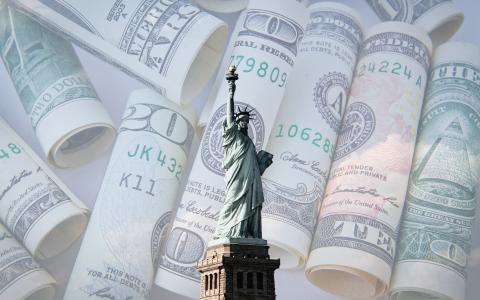
(Bloomberg) - The 20-year Treasury bond offered a grim warning as a selloff fueled by inflationary angst gripped global debt markets: 5% yields are already here.
The 20-year yield, a laggard on the US government debt curve since its re-introduction in 2020, topped 5% Wednesday for the first time since 2023. The move, fueled in part by concern that President-elect Donald Trump’s policies will rekindle price pressures and lead to wider deficits, indicates what’s potentially next in the $28 trillion Treasury market.
The 30-year yield topped 4.96%, while the 10-year rose as much as four basis points to nearly 4.73% — just shy of its highest level since November 2023. The moves echoed the run-up in yields seen in the UK and across emerging markets.
“The US market is having an outsized effect as investors grapple with sticky inflation, robust growth and the hyper-uncertainty of incoming President Trump’s agenda,” said James Athey, a portfolio manager at Marlborough Investment Management.
Treasury yields have been climbing since the Federal Reserve in September kicked off its interest-rate cutting cycle with an outsized half-point move. A resilient US economy and Trump’s White House victory less than two months later fueled the moves further, leaving the 10-year yield more than 100 basis points higher than it was before the Fed’s debut rate reduction.
“Treasury yields at 5% is definitely on the cards,” said Lilian Chovin, head of asset allocation at Coutts. “There’s a risk premium, a term premium going on with the very large fiscal deficits.”
From Amundi SA and Citi Wealth to ING, firms are increasingly acknowledging a new era of higher yields, and options traders are targeting the 5% level. It’s a rude awakening for a market that had broadly expected yields to fall as central banks pivoted from aggressive rate hikes to cuts.
New Era
The 20-year bond yield, though an outlier on the curve because it’s a relatively new tenor, is subject to the same pressures as the others. Yields retreated slightly from the day’s highs after the ADP gauge of private-sector hiring was weaker than anticipated for December.
All that has forced bond investors to contend with the possibility that the benchmark yield could soon return to 5% — a level that has been breached only a handful of times over the past decade, most recently in late 2023.
The level has also come into focus as the US government issues a whopping $119 billion worth of new debt this week. A sale of 30-year bonds lies ahead at 1 p.m. New York time and stands to draw the highest yield since 2007 — like the 10-year auction did on Tuesday. The Treasury also sold three-year notes on Monday.
Shifts in open interest data on US 10-year note futures indicate that traders have added to bets on higher yields every day so far this year, likely helping to exacerbate the yield’s move closer to 5%. The data also offered evidence that traders had strong appetite for new bearish wagers.
Such a rapid build-up of short positions in the first days of 2025, of course, stands to potentially spur volatility around upcoming economic data releases. That puts bond investors on high alert ahead of readings of the US labor market on Friday and consumer price inflation next Wednesday.
Higher yields also raise the stakes as Fed officials — who’ve cut borrowing costs three times this cycle — aim to get inflation under control without triggering a downturn of the economy. Projections updated last month showed the median policymaker expects two additional cuts in 2025.
Fed Governor Christopher Waller on Wednesday said he believes inflation will continue to cool toward the central bank’s 2% target, offering support for additional cuts this year.
Traders, meanwhile, are pricing in a cumulative 36 basis points of easing this year — implying no more than one quarter-point reduction. The first such move isn’t fully priced in until July.
By Sydney Maki and Alice Gledhill
With assistance from Sujata Rao and Edward Bolingbroke



